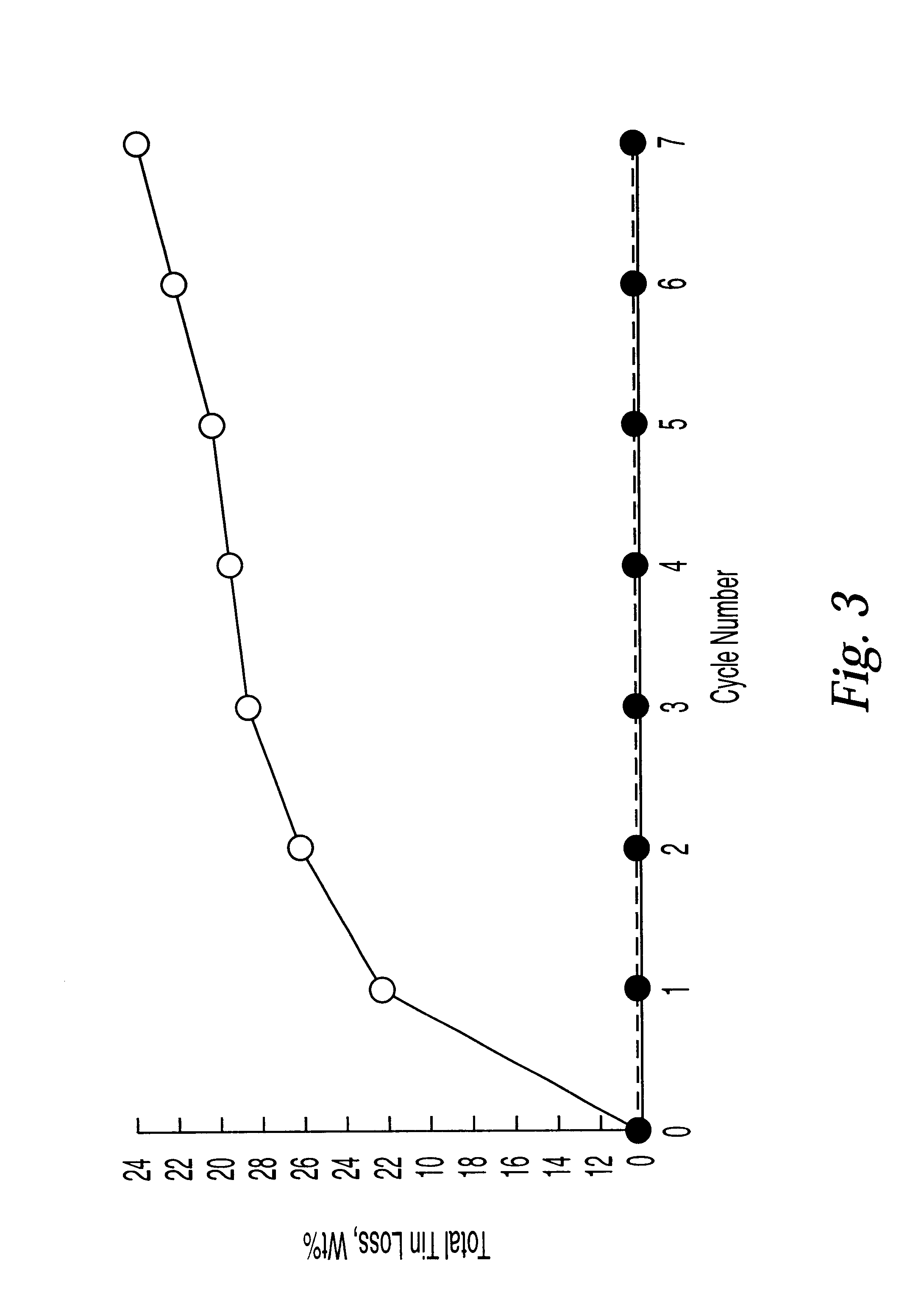Method for removing reactive metal from a reactor system
a reactor system and reactive metal technology, applied in metal/metal-oxide/metal-hydroxide catalysts, chemical/physical processes, etc., can solve the problems of not teaching the desirability nor the need for removing metal from the reactor system, and the catalyst activity is reduced unexpectedly and undesired, so as to improve the reproducibility of catalytic operations and reduce catalyst contamination
- Summary
- Abstract
- Description
- Claims
- Application Information
AI Technical Summary
Benefits of technology
Problems solved by technology
Method used
Image
Examples
example 1a
Stanniding Steel Using a Tin Paint
Coupons of type 321 type or type 347 stainless steel were coated with a tin-containing paint. The paint consisted of a mixture of 2 parts powdered tin oxide, 2 parts finely powdered tin (1-5 microns), 1 part stannous neodecanoate in neodecanioc acid (20% Tin Tem-Cem manufactured by Mooney Chemical Inc., Cleveland, Ohio which contained 20% tin as stannous neodecanoate) mixed with isopropanol, as described in WO 92 / 15653. The coating was applied to the steel surface by painting and letting the paint dry in air. After drying, the painted steel was contacted with flowing hydrogen at 1100.degree. F. for 40 hr to produce a stannided steel surface comprising intermetallics including iron stannides.
Some experiments were done in a pilot plant having 1 / 4" OD reactor tube made of 316 stainless steel. The reactor tube was coated with the tin-containing paint described above. The coating was applied to the inner surface of the pilot plant by filling the reactor ...
example 1b
Analysis of Stannided Steel
The resulting tin coated steels with their intermetallic tin layers were examined visually for completeness of coating. Samples were mounted in a clear epoxy resin and then ground and polished in preparation for analysis with the petrographic and scanning electron microscopes (SEM). EDX analysis can be used to determine the chemical composition of the layers. The cross-sections of the materials showed that the tin paint had reduced to metallic tin under these conditions and formed a continuous and adherent metallic (iron / nickel stannide) protective layer on the steel surface. Nickel- and iron-containing stannides were present at a thickness of between about 2 to 5 microns. A nickel depleted underlayer (2-5 microns thick) was also present. On the surface, microscopic tin balls and globules were observed.
example 2
Preparing a Halided Platinum L-zeolite Catalyst
A halided platinum L-zeolite catalyst was prepared in a manner similar to EP 498,182A1, Example 4. Experiments showed that this catalyst evolved HCl and HF when heated to 500.degree. F. in the presence of hydrogen. FIG. 1 shows HCl evolution as a function of temperature. HF loss is also observed. Gastec tubes were used to measure HCl concentration. Gas rates were 1300 GHSV, once-through. Hydrogen was added at time=79 hours. This catalyst was used for all the activity tests described below and as a source HCl and HF in some of the following examples.
PUM
| Property | Measurement | Unit |
|---|---|---|
| particle size | aaaaa | aaaaa |
| particle size | aaaaa | aaaaa |
| temperatures | aaaaa | aaaaa |
Abstract
Description
Claims
Application Information
 Login to View More
Login to View More - R&D
- Intellectual Property
- Life Sciences
- Materials
- Tech Scout
- Unparalleled Data Quality
- Higher Quality Content
- 60% Fewer Hallucinations
Browse by: Latest US Patents, China's latest patents, Technical Efficacy Thesaurus, Application Domain, Technology Topic, Popular Technical Reports.
© 2025 PatSnap. All rights reserved.Legal|Privacy policy|Modern Slavery Act Transparency Statement|Sitemap|About US| Contact US: help@patsnap.com



